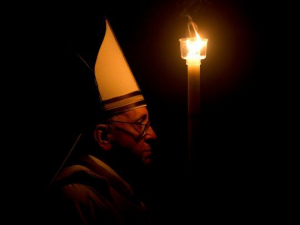What do you know about ‘the most noble of all solemnities’?
By most ancient Tradition, this is the night of keeping Vigil for the Lord (Ex 12:42), in which, following the Gospel admonition (Lk 12:35-37), the faithful, carrying lighted lamps in their hands, should be like those looking for the Lord when He returns, so that at His coming, He may find them awake and have them sit at His table.
Of this night’s Vigil, which is the greatest and most noble of all  solemnities, there is to be only one celebration in each church. It is arranged, moreover, in such a way that after the Lucernarium and Easter Proclamation (which constitutes the first part of this vigil), Holy Church meditates on the wonders the Lord God has done for His people from the beginning, trusting in His word and promise (the second part, that is, the Liturgy of the Word) until, as day approaches, with new members reborn in Baptism ( the third part), the Church is called to the table the Lord prepared for His people, the memorial of His Death and Resurrection until He comes again (the fourth part).
solemnities, there is to be only one celebration in each church. It is arranged, moreover, in such a way that after the Lucernarium and Easter Proclamation (which constitutes the first part of this vigil), Holy Church meditates on the wonders the Lord God has done for His people from the beginning, trusting in His word and promise (the second part, that is, the Liturgy of the Word) until, as day approaches, with new members reborn in Baptism ( the third part), the Church is called to the table the Lord prepared for His people, the memorial of His Death and Resurrection until He comes again (the fourth part).
The entire celebration of the Easter Vigil must take place during the night, so it begins after nightfall and ends before daybreak on the Sunday.
Dead men cannot take effective action; their power of influence on others lasts only till the grave. Deeds and actions that energise others belong only to the living. Well, then, look at the facts in this case. The Saviour is working mightily among men, every day he is invisibly persuading numbers of people all over the world, both within and beyond the Greek-speaking world, to accept his faith and be obedient to his teaching. Can anyone, in face of this, still doubt that he has risen and lives, or rather that he is himself the Life? Does a dead man prick the consciences of men…?
– St Athanasius of Alexander

Comments are closed, but trackbacks and pingbacks are open.